The Economics and Statistics Division maintains archives of previous publications for accountability purposes, but makes no updates to keep these documents current with the latest data revisions from Statistics Canada. As a result, information in older documents may not be accurate. Please exercise caution when referring to older documents. For the latest information and historical data, please contact the individual listed to the right.
<--- Return to Archive
For additional information relating to this article, please contact:
December 20, 2017WHOLESALE TRADE, OCTOBER 2017 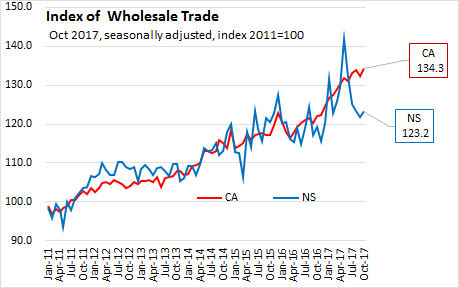
In Nova Scotia October 2017, the seasonally adjusted index of growth (2011=100) increased 1.5 points to 123.2. Since January 2017, growth in wholesale trade has been highly volatile: starting at 131.7 in January, declining to a low of 122.9 in Febrruary, increasing sharply to a new high of 141.8 in May, only to decline sharply to 121.7 in September. In October the index turned a corner and began increasing again.
In Nova Scotia October 2017, on a seasonally adjusted basis month-over-month wholesale sales increased 1.2 per cent to $804 million. On a year-over-year basis, wholesale sales were 3.3 per cent higher than October 2016. On a year-to-date basis (Jan-Oct total) wholesale sales were 7.7% higher than the same period last year.
In Canada October 2017, on a seasonally adjusted basis the wholesale index of growth (2011=100) increased 2.0 points to 134.3. On a month-over-month basis, wholesale sales increased 1.5 per cent to $63.0 billion. On a year-over-year basis, wholesale sales were 10.0 per cent higher over October 2016. On a year-to-date basis (Jan-Oct totals) wholesale sales were 9.4% higher than the same period last year.
In Canada October 2017, sales were up in six of seven industries, over the previous month:
- Machinery and equipment subsector were up 5.2% to $12.7 billion.
- Food and beverage were up 1.8% to $12.0 billion.
- Personal and household goods sales were up 3.4% to $8.9 billion.
- Building materials and supplies were up 0.3% to $8.9 billion.
- Miscellaneous subsector increased 0.2% to $8.0 billion.
- Farm product was up 4.2% to $852 million.
- Motor vehicle and parts decreased 2.3% to $11.8 billion.
By Province
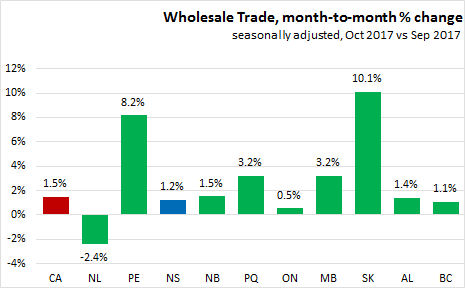
In month-over-month seasonally adjusted wholesale sales, Nova Scotia (+1.2%) ranked 7th. Alberta led the way with sales increasing 10.1%. Only one of ten provinces reported negative growth. Sales were up in nine provinces.
On a year-over-year basis, Nova Scotia (+3.3%) ranked 9th. Saskatchewan led the way with growth in sales increasing 21.4% over October 2016. Alberta (+15.0%), Manitoba (+12.7%), Quebec (+12.6%), Ontario (+12.5%) and Prince Edward Island (+10.7%) also recorded double digit growth over the same period last year. The other four provinces reported single digit, positive growth in the 1.4% to 8.1% range.
On a year-to-date basis, Nova Scotia (+7.7%) ranked 8th. Prince Edward Island recorded the highest sales growth at 11.9%. British Columbia (+11.1%), Alberta (+10.3%), and Quebec (+10.2%) also recorded double-digit year-to-date growth. The other six provinces reported single digit growth in the range of 6.1% to 8.9%. Canada recorded a 9.4% growth in wholesale trade.
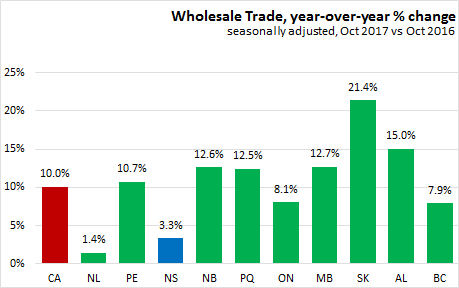
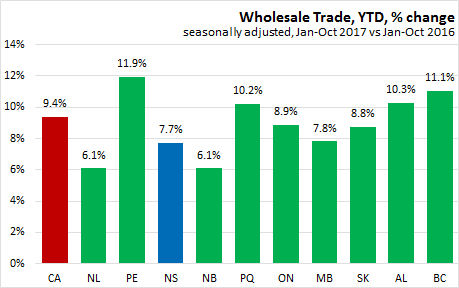
Nova Scotia Sectors
Statistics Canada now releases seasonally adjusted wholesale trade data by sector at the provincial level. As there has been significant volatility in recent wholesale values for Nova Scotia. Year-to-date comparisons are more indicative of economic conditions for volatile indicators and seasonally adjusted wholesale values will also smooth out the indicator.
Year-to-date wholesale sales by sector in Nova Scotia increased by $597 million, or by 7.7 per cent compared to Jan-Oct 2016. The dollar increase was largely accounted for by four subsectors: Food, beverage and tobacco wholesalers (+$318 million); building material and supplies wholesalers (+$191 million), Machinery/equipment ($123 million), and Motor vehicle and parts ($111 million). One subsector had a decline: miscellaneous wholesalers declined $98 million.
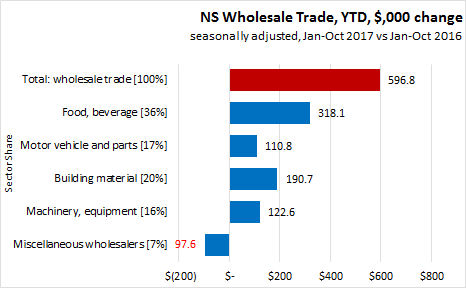
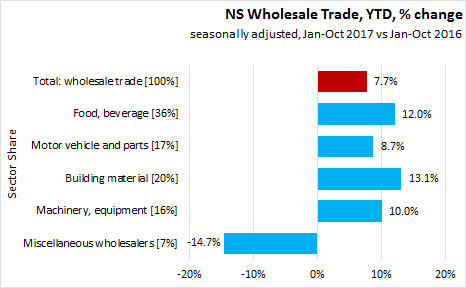
Statistics Canada: CANSIM table 081-0011
<--- Return to Archive